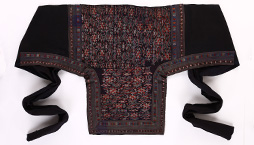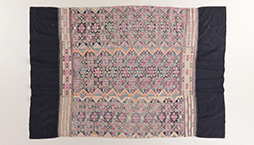Stunning Craftsmanship in Costumes and Accessories
The techniques involved in making the ethnic costumes and accessories of Guizhou 貴州 are numerous and complex. From applying a single technique to mixing several, many diverse patterns can be created, and the results are lustrous and impressive. Be it batik dyeing, fabric embroidery, needle weaving, or silver forging, each ethnic group has developed its own unique specialty. The fineness of embroideries, the exquisiteness of batik textiles, the preciseness of needlework, and the sumptuousness of silver ornaments are all breathtakingly spectacular, attesting to the ingenuity and aesthetic tastes of the various nationalities. While the history and culture of an ethnic group differ from those of the others, the patterns on the costumes may reveal the sentiments, stories, and memories that cannot otherwise be conveyed orally or by written words. A walk through the exhibits in this section may be likened to reading the history of the development of the ethnic nationalities’ costumes and accessories from Guizhou.




